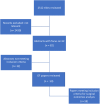Gluteal Fibrosis and Its Surgical Treatment
- PMID: 30801376
- PMCID: PMC6738551
- DOI: 10.2106/JBJS.17.01670
Gluteal Fibrosis and Its Surgical Treatment
Abstract
Background: The objective of this study was to analyze the literature regarding the diagnosis, pathogenesis, and prevalence of gluteal fibrosis (GF) and the outcomes of treatment.
Methods: We searched PubMed, Embase, and Cochrane literature databases, from database inception to December 15, 2016. We used the following search terms including variants: "contracture," "fibrosis," "injections," "injections, adverse reactions,' "gluteal," and "hip." All titles and abstracts of potentially relevant studies were scanned to determine whether the subject matter was potentially related to GF, using predefined inclusion and exclusion criteria. If the abstract had subject matter involving GF, the paper was selected for review if full text was available. Only papers including ≥10 subjects who underwent surgical treatment were included in the systematic analysis. Data abstracted included the number of patients, patient age and sex, the type of surgical treatment, the method of outcome measurement, and outcomes and complications.
Results: The literature search yielded 2,512 titles. Of these, 82 had a focus on GF, with 50 papers meeting the inclusion criteria. Of the 50 papers reviewed, 18 addressed surgical outcomes. The surgical techniques in these papers included open, minimally invasive, and arthroscopic release and radiofrequency ablation. Of 3,733 operatively treated patients in 6 reports who were evaluated on the basis of the criteria of Liu et al., 83% were found to have excellent results. Few papers focused on the incidence, prevalence, and natural history of GF, precluding quantitative synthesis of the evidence in these domains.
Conclusions: This study provided a systematic review of surgical outcomes and a summary of what has been reported on the prevalence, diagnosis, prognosis, and pathogenesis of GF. Although GF has been reported throughout the world, it requires further study to determine the exact etiology, pathogenesis, and appropriate treatment. Surgical outcomes appear satisfactory.
Level of evidence: Therapeutic Level IV. See Instructions for Authors for a complete description of levels of evidence.
Figures
References
-
- Aggarwal A, Singh S, Singh M, Chauhan R. Idiopathic bilateral gluteus maximus contracture: a case report and review of literature. Acta Orthop Belg. 2005. August;71(4):493-5. - PubMed
-
- Al Bayati MA, Kraidy BK. Gluteal muscle fibrosis with abduction contracture of the hip. Int Orthop. 2016. March;40(3):447-51. Epub 2015 Jul 2. - PubMed
-
- Brignall CG, Brown RM, Stainsby GD. Fibrosis of the gluteus maximus as a cause of snapping hip. A case report. J Bone Joint Surg Am. 1993. June;75(6):909-10. - PubMed
-
- Cai JH, Gan LF, Zheng HL, Li H. Iliac hyperdense line: a new radiographic sign of gluteal muscle contracture. Pediatr Radiol. 2005. October;35(10):995-7. Epub 2005 Jun 18. - PubMed
-
- Chen SS, Chien CH, Yu HS. Syndrome of deltoid and/or gluteal fibrotic contracture: an injection myopathy. Acta Neurol Scand. 1988. September;78(3):167-76. - PubMed






